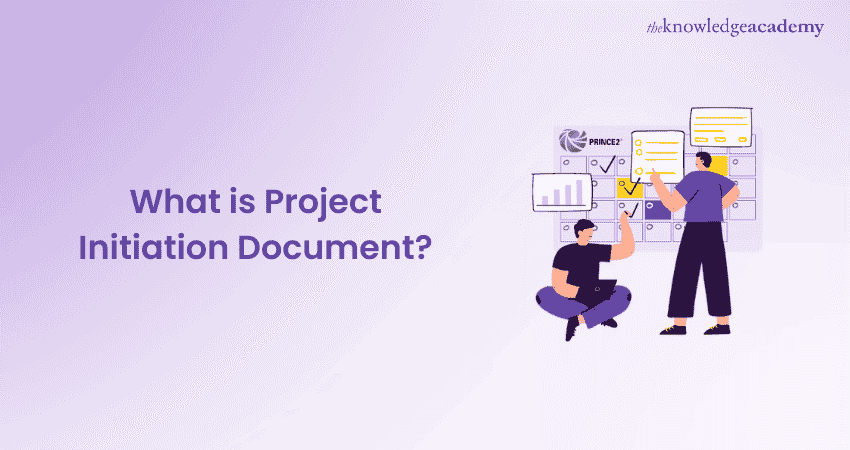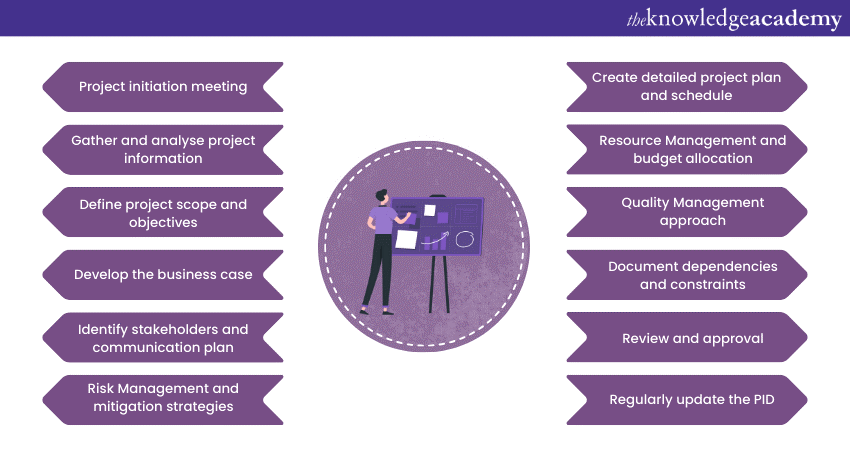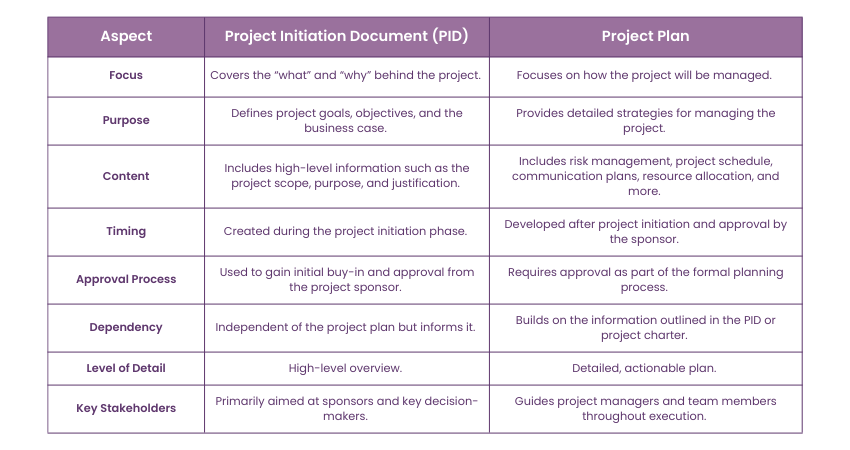We may not have the course you’re looking for. If you enquire or give us a call on 01344203999 and speak to our training experts, we may still be able to help with your training requirements.
We ensure quality, budget-alignment, and timely delivery by our expert instructors.

If every great project is considered a story, then the Project Initiation Document (PID) functions as the opening chapter. Acting as a roadmap, it outlines the "what" and "why" behind a project, outlining the objectives, scope, stakeholders, and the business case.
You can think of it as your project’s manifesto that rallies your team and ignites stakeholder excitement. This blog explores the question “What is a Project Initiation” Document, detailing its importance, components, template and more. So read on and learn how PIDs can set your projects up for triumph.
Table of Contents
1) What is a Project Initiation Document?
2) Why Is a Project Initiation Document Important?
3) Components of a Project Initiation Document
4) Creating a Project Initiation Document
5) Project Initiation Document Template
6) Project Initiation Document Vs Project Plan
7) What is the Purpose of a PID?
8) Is a PID the Same as a PMP?
9) Conclusion
Role of a Project Initiation Document
A Project Initiation Document (PID), also known as a project brief or project charter, is a sheet that outlines a project's key components, including client expectations, scope, context, team members and metrics of progress and success. It guides internal and external stakeholders in understanding the project plan and tracking progress toward objectives.
A project's guidelines must be crystal clear and accessible to everyone involved. If a problem arises, team members can consult the initiation document to clarify previously agreed-upon terms, tasks and responsibilities.
Why Is a Project Initiation Document Important?
A Project Initiation Document is highly important for the following reasons:
1) During the initiation phase, the PID collects most of the other project documents from that phase, ensuring that the project is understood fully before taking it to the project board.
2) It acts as the baseline so the project board and project manager can refer to it and track their progress.
3) It can help identify issues that may arise and impact on the project's scope, cost or time.
4) The Project Initiation Document is a great tool to bring new project members up to speed. They can learn all they need to know about the project in one place, including its reason, risks, business justification, how it’s managed, and more.

Master PRINCE2 with our expert-led PRINCE2® Training – join today!
Components of a Project Initiation Document
A Project Initiation Document (PID) in PRINCE2 is a comprehensive document that outlines the foundational aspects of a project. It provides a detailed blueprint, ensuring all stakeholders are on the same wavelength regarding the project's objectives, scope, risks, resources, and methodologies. Let’s explore the key components of a PID in PRINCE2:
1) Project Overview and Objectives
This section outlines the project's purpose, detailing what needs to be achieved. It includes a concise summary of the project, its goals, and the benefits it aims to deliver to the organisation. Defining the objectives clearly sets the direction from the outset.
2) Business Case
The business case justifies the project’s viability. It includes an analysis of costs, benefits, risks, and potential returns on investment. A well-structured business case helps stakeholders understand financial implications, enabling them to make informed decisions about its feasibility.
3) Project Organisation and Roles
This section describes the project’s organisational structure. It defines the roles and responsibilities of team members, stakeholders, and decision-makers. A clear hierarchy ensures efficient communication and accountability, vital for successful Project Management.
4) Stakeholder Analysis and Communication Plan
Identifying stakeholders and understanding their interests is crucial. This component analyses stakeholders' expectations, concerns, and communication preferences. The communication plan establishes how information will be disseminated, ensuring stakeholders are engaged and informed throughout the lifecycle.
5) Risk Management Plan
Risk Management is pivotal in Project Management. This section identifies potential risks, their impact, likelihood, and mitigation strategies. By addressing risks proactively, the Project team can minimise potential issues, ensuring the project stays on track.

6) Quality Management Approach
Quality standards and procedures are outlined here. It defines the project's quality objectives, methods for quality control, and criteria for success. Adherence to these standards guarantees the delivery of a high-quality end product or service.
7) Project Plan and Schedule
This component provides a detailed plan, including tasks, milestones, deadlines, and dependencies. It establishes a structured timeline. This allows stakeholders to track progress, identify bottlenecks, and ensure the project stays on schedule.
8) Resource Management Plan
Managing resources efficiently is critical. This section outlines the human, financial, and physical resources required for the project. It specifies how resources will be acquired, allocated, and managed throughout the project, ensuring optimal utilisation.
9) Budget and Cost Management
Financial aspects are detailed here. The budget outlines the overall cost of the project, including expenditures and contingencies. Cost Management strategies ensure that the project stays within budgetary constraints, avoiding financial overruns.
10) Change Management Plan
This component outlines procedures for handling changes in scope, objectives, or requirements. It defines the process for evaluating change requests. As a result, it ensures that changes are implemented systematically and do not disrupt the project's flow.
Elevate your Project Management skills with our PRINCE2 Foundation Course – sign up now for a brighter future!
Creating a Project Initiation Document
Creating a Project Initiation Document (in PRINCE2 involves a strategic and meticulous process that lays the groundwork for a successful project. So, let’s delve into the step-by-step approach of crafting a PID, outlining the essential stages and best practices that Project Managers should follow:

1) Project Initiation Meeting
The PID process often begins with an initiation meeting. In this session, key stakeholders, Project Managers, and team members gather to discuss objectives, scope, constraints, and expectations. This meeting sets the overall tone for the project and provides valuable insights that shape the PID’s content.
2) Gather and Analyse Project Information
The project team gathers all necessary information, including project requirements, objectives, and stakeholder expectations. Moreover, they analyse existing documents, conduct interviews, and collaborate with experts to ensure a comprehensive understanding of the project’s intricacies. This step forms the basis for the PID’s content.
3) Define Project Scope and Objectives
Here, the project’s scope is clearly defined, outlining what is included and, equally importantly, what is not. Project team establishes SMART (Specific, Measurable, Achievable, Relevant, Time-bound) objectives. These objectives serve as the project’s compass, guiding all subsequent decisions and actions.
4) Develop the Business Case
Further, the team crafts a compelling business case that justifies the project’s existence. This involves evaluating costs, benefits, risks, and potential returns on investment. The business case should present a clear rationale, demonstrating how the project aligns with organisational goals and contributes to strategic objectives.

5) Identify Stakeholders and Communication Plan
Next, the team conducts a stakeholder analysis to identify every individual or group affected by the project. They understand their interests, concerns, and communication preferences. Further, they develop a communication plan detailing what information will be communicated, to whom, and through which channels. Effective stakeholder engagement is the key to project success.
6) Risk Management and Mitigation Strategies
The project team identifies potential risks and uncertainties related to the project, assessing their impact and likelihood. After collecting the information about possible risks, they develop mitigation and contingency plans to address these risks. By proactively managing risks, the project team can anticipate challenges and formulate strategies to overcome them, ensuring smoother execution.
7) Create Detailed Project Plan and Schedule
Further, they develop a detailed project plan outlining tasks, dependencies, milestones, and deadlines. The team uses Project Management tools to create Gantt charts or any other visual representation of the schedule. A well-structured plan delivers a roadmap for the Project team, enabling them to track its progress and make necessary adjustments.
8) Resource Management and Budget Allocation
As the next step, the project team allocates resources such as human capital, equipment, and finances. Team members ensure resources are optimally utilised to achieve objectives. Further they develop a budget, detailing all expenditures and contingencies. Resource Management and budget allocation must align with the project plan to avoid bottlenecks and financial overruns.
9) Quality Management Approach
They also define quality standards and procedures that the project will adhere to. The team outlines methods for quality control and establishes criteria for success. Quality Management ensures that the end product or service meets the required standards, satisfying stakeholders and enhancing the project’s reputation.
10) Document Dependencies and Constraints
The most important task is to identify project dependencies, both internal and external, and constraints such as time, budget, or regulatory limitations. Documenting dependencies and constraints provides a clear understanding of factors that might impact the project’s progress. This allows the team to plan accordingly and manage expectations.
11) Review and Approval
Once the PID is complete, the team conduct a thorough review with key stakeholders. They gather feedback and make necessary revisions. Moreover, they obtain formal approval from relevant authorities. A signed-off PID signifies consensus and commitment, ensuring that the involved people is aligned with the project’s goals and strategies.
12) Regularly Update the PID
A PID is not a static document. Thus, the project team requires regularly updating it as the project progresses and new information emerges. They address changes in scope, objectives, risks, or resource allocation promptly. Lastly, the team keeps the PID current and ensures that they are working with accurate and relevant information, enabling effective decision-making.
Want to become a professional Project Manager? Register for our PRINCE2 Practitioner Course for a brighter future!
Project Initiation Document Template
Here’s the ideal PID template:
|
Project Definition • Purpose: Reason for initiating the project (e.g., fill a niche, launch a new product). • Goals & Objectives: Long-term outcomes (goals) and short-term outcomes (objectives). • Success Criteria: Metrics to determine project success. • Assumptions & Constraints: Assumptions (assumed true) and constraints (proven true). Business Case • Justifies the project's existence, detailing benefits, costs, and risks. Project Scope • Comprehensive document defining goals, constraints, workflow, strategies, tasks, and deliverables. Project Budget • Estimate of all costs related to completing the project, including phase-wise estimates and historical data. Project Timeline • Schedule of all tasks, deadlines, and milestones mapped on a timeline. Project Breakdown • Work breakdown structure identifying all project deliverables. Resource Plan • Identification and efficient allocation of all necessary resources (human, equipment, materials). Risk Plan • Identification of potential risks, mitigation plans, impact estimation, and response prioritization. Change Management Plan • Process for reviewing, accepting/rejecting, and implementing changes to manage scope, time, and cost impacts. Project Team Roles & Responsibilities • Definition and communication of roles and responsibilities for all team members. Project Controls • Process of collecting and analyzing project data to ensure schedule, budget, performance, and quality adherence. Communication Plan • Defines how, when, and with what frequency information will be disseminated to stakeholders, ensuring everyone stays informed. |
Project Initiation Document Vs Project Plan
The following table summarises the difference between a PID and a project plan

Don't miss out on career growth! See why do Management Professionals Need PRINCE2 Training and how it can help you gain mastery in project management methodologies.
What is the Purpose of a PID?
The purpose of a PID in Project Management is to assemble all key information in one place that'll help you keep a project on track from start to finish. It gives everyone involved a clear idea of what is required of them and what steps must be taken to reach the endpoint.
Is a PID the Same as a PMP?
A PID is different from a Project Management Plan (PMP). The PID outlines the project's objectives, scope, stakeholders, and key deliverables. On the other hand, the PMP is a detailed document outlining how the project will be executed, monitored, and closed (including all aspects of Project Management processes).
Conclusion
To sum things up, the Project Initiation Document stands as an important component of any Project Management methodology. By following the guidelines outlined in this blog on What is a Project Initiation Document and how to create a PID, Project Managers can harness the true power of the document. This will steer your projects towards triumph amidst challenges and uncertainties.
Learn how to manage resources, project timelines and stakeholders with our PRINCE2 Agile Foundation and Practitioner Training – sign up today!
Frequently Asked Questions
What is a project initiation example?

A good example of PID can involve a software development project for creating a new mobile application. The project initiation involves defining the objective of building a feature-rich, user-friendly app that improves productivity. The next steps include identifying stakeholders and risks and outlining resources.
Why should you use a project charter?

statement of the objectives, scope of work, and participants for a project. It helps align the entire team. The main reasons you must consider a project charter are:
a) Ensures better Time Management.
b) Helps establish your team’s budget.
c) Helps with team morale.
What are the Other Resources and Offers Provided by The Knowledge Academy?

The Knowledge Academy takes global learning to new heights, offering over 3,000 online courses across 490+ locations in 190+ countries. This expansive reach ensures accessibility and convenience for learners worldwide.
Alongside our diverse Online Course Catalogue, encompassing 19 major categories, we go the extra mile by providing a plethora of free educational Online Resources like News updates, Blogs, videos, webinars, and interview questions. Tailoring learning experiences further, professionals can maximise value with customisable Course Bundles of TKA.
What is The Knowledge Pass, and How Does it Work?

The Knowledge Academy’s Knowledge Pass, a prepaid voucher, adds another layer of flexibility, allowing course bookings over a 12-month period. Join us on a journey where education knows no bounds.
What are the Related Courses and Blogs Provided by The Knowledge Academy?

The Knowledge Academy offers various PRINCE2® Training, including the PRINCE2® Foundation and Practitioner 7th Edition Training and the PRINCE2 Agile® Foundation Training. These courses cater to different skill levels, providing comprehensive insights into Digital Project Management Process.
Our Project Management Blogs cover a range of topics related to Project Initiation, offering valuable resources, best practices, and industry insights. Whether you are a beginner or looking to advance your Project Management skills, The Knowledge Academy's diverse courses and informative blogs have got you covered.






 Top Rated Course
Top Rated Course




 If you wish to make any changes to your course, please
If you wish to make any changes to your course, please


